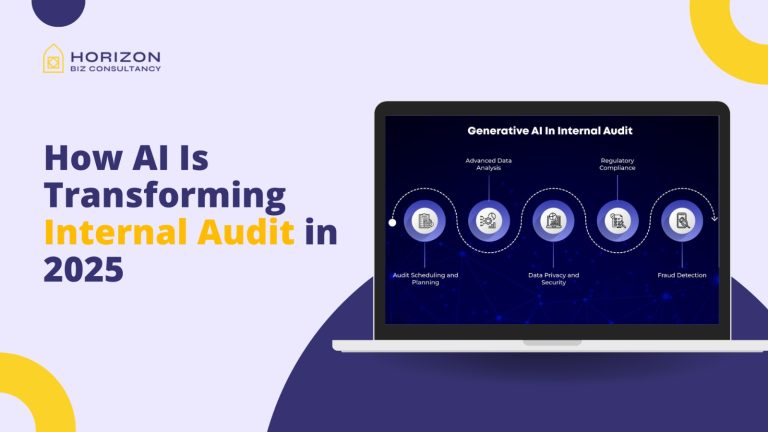Introduction
Internal audit has always been the backbone of organizational governance. Traditionally, it revolved around checklists, control testing, and post-event evaluations. But in 2025, with businesses navigating an increasingly complex risk environment, artificial intelligence (AI) is reshaping how internal audits are performed. Instead of being reactive, audits are now becoming proactive, predictive, and deeply strategic.
AI allows organizations to harness vast volumes of structured and unstructured data, identify anomalies in real time, and anticipate risks before they occur. This shift is not merely about digitization, it’s about reimagining the role of internal audit as a forward-looking partner in governance, risk management, and compliance.
From Manual Testing to Predictive Auditing
Conventional audits relied heavily on manual sampling and selective testing, which often meant issues were discovered after they had already impacted the business. This backwards-looking approach had inherent limitations: missed fraud, undetected inefficiencies, and delays in compliance reporting.
AI eliminates these constraints by enabling full-population testing and predictive analysis. Instead of looking at only 5–10% of data samples, AI tools can process millions of transactions in seconds, offering complete coverage and uncovering patterns that humans alone might miss.
Examples of AI in action:
- Transaction Monitoring: AI algorithms can scan entire ledgers instantly, flagging duplicate payments, unusual vendor activity, or out-of-pattern transactions.
- Expense Analysis: Machine learning identifies recurring patterns in travel, procurement, or reimbursements, allowing it to detect inflated claims or potential collusion.
- Regulatory Compliance: AI-driven systems continuously update audit controls as global regulations evolve, ensuring organisations remain compliant without waiting for annual audits.
This predictive capacity transforms audit from a “look-back exercise” into a “look-forward safeguard.”
Key AI Applications in Internal Audit
AI’s influence in 2025 spans a wide array of applications, each designed to make audits more intelligent, agile, and scalable.
- Natural Language Processing (NLP): NLP tools can review contracts, employee communications, and policy documents, surfacing hidden risks such as ambiguous clauses, non-compliance with local labour laws, or red flags in procurement language.
- Robotic Process Automation (RPA): RPA handles repetitive audit tasks like extracting data from invoices, reconciling balances, and compiling reports, freeing auditors to focus on higher-value judgments.
- Predictive Analytics: Instead of providing hindsight-based reports, predictive models offer foresight, such as estimating which business units are most likely to breach compliance within the next quarter.
- Continuous Auditing: With AI, organisations can shift from periodic quarterly or annual reviews to always-on monitoring, providing real-time assurance and early-warning alerts.
- Generative AI for Reporting: Modern audit teams are beginning to use generative AI to summarise findings, draft risk assessments, and prepare audit reports, reducing turnaround time.
Benefits Organizations Are Seeing in 2025
The adoption of AI in internal audit is no longer experimental; it’s mainstream, and businesses are already reaping measurable benefits:
- Speed: Audits that once took months can now be executed in weeks or even days. This is particularly critical for multinational organisations with complex supply chains and diverse regulatory exposures.
- Accuracy: AI reduces human error, eliminates sampling bias, and ensures that 100% of the data is reviewed.
- Scalability: Whether auditing a single subsidiary or a global conglomerate, AI systems scale effortlessly without requiring proportional increases in audit staff.
- Fraud Detection: By using behavioural analytics, AI detects sophisticated fraud schemes that might bypass traditional controls.
- Regulatory Trust: Regulators are increasingly recognising AI-supported audits as more transparent, reliable, and objective, enhancing stakeholder confidence.
- Cost Efficiency: Though initial investments in AI systems are significant, organisations report long-term savings due to reduced manpower needs and fewer regulatory penalties.
Comparison Table: Traditional vs AI-Powered Internal Audit
| Aspect | Traditional Audit | AI-Powered Audit (2025) |
| Data Coverage | Sampling | 100% dataset analysis |
| Frequency | Periodic (quarterly/annual) | Continuous (real-time) |
| Risk Identification | After the fact | Predictive & proactive |
| Resource Dependency | High (manual effort) | Optimised (automation-driven) |
| Regulatory Confidence | Moderate | High (AI-backed assurance) |
The Human-AI Balance
A common misconception is that AI will replace auditors. The reality is the opposite: AI enhances the auditor’s role. Instead of spending hours reconciling spreadsheets or sampling invoices, auditors can now focus on strategic risk advisory.
AI surfaces anomalies and insights, but it cannot interpret business context or ethical considerations. Human auditors bring judgment, industry expertise, and the ability to recommend actionable solutions tailored to an organisation’s culture and strategy. The partnership between AI and auditor technology for speed and humans for judgment is where true value is created.
Challenges in Adoption
Despite its potential, AI-driven auditing is not without challenges. Organisations must navigate both technical and human hurdles:
- Model Validation: Ensuring that AI algorithms are unbiased, explainable, and auditable themselves is critical. Black-box AI models can undermine trust if stakeholders cannot understand their decisions.
- Cybersecurity Risks: AI systems rely on sensitive audit data. Protecting this data from cyberattacks and breaches is paramount.
- Skill Gaps: Auditors require new skills in data science, analytics, and AI tools. Upskilling and training programs are essential.
- Integration Issues: AI systems must work seamlessly with ERP, compliance, and governance frameworks, which
AI in Financial Sector Audits
Banks and financial institutions were among the earliest adopters of AI in audit. For example, AI-driven transaction monitoring in large banks now detects fraudulent credit card activity within seconds, preventing billions in potential losses. Similarly, compliance audits for anti-money laundering (AML) are being performed continuously, reducing penalties and building regulator trust.
Other sectors like healthcare, manufacturing, and e-commerce are following suit, using AI to review procurement contracts, supplier risks, and even ESG (Environmental, Social, Governance) reporting accuracy.
Looking Ahead: The Future of AI in Audit
By 2030, experts predict that up to 90% of audit processes will involve AI automation. Internal audit will no longer be a retrospective compliance function but an integrated, forward-looking business partner.
Future developments may include:
- Self-learning audit platforms that adapt to emerging risks without human programming.
- Blockchain-audited AI systems that create immutable, transparent audit trails.
- AI-driven ESG audits as sustainability reporting becomes a regulatory requirement.
- Global regulatory collaboration, where AI-generated audit data is directly integrated into regulators’ systems for real-time oversight.
Companies adopting AI today are building not just compliance strength but also strategic resilience. In competitive industries, AI-enabled audit is quickly becoming a differentiator.
Conclusion:
AI is no longer just a supporting tool; it’s a game-changer for internal audit in 2025. By moving from sampling to full-population testing, from reactive to predictive insights, and from manual processes to automation, organisations are redefining the audit function.
Businesses that embrace AI-driven audits can demonstrate transparency, manage risks proactively, and strengthen stakeholder trust. Those that delay adoption risk being left behind in a governance environment that is becoming real-time, data-driven, and globally interconnected.
FAQ’s
AI automates data analysis, identifies anomalies, and provides predictive insights, helping auditors move beyond manual sampling to continuous monitoring.
By scanning 100% of transactions in real time, AI reduces false positives, speeds up risk detection, and allows auditors to focus on critical issues.
Yes. AI uses behavioral analytics and pattern recognition to detect unusual activity and hidden fraud schemes that traditional audits often miss.
No. AI enhances auditors’ capabilities by handling repetitive tasks and risk analysis, while human auditors provide judgment, ethics, and contextual insights.
Key challenges include data quality issues, skill gaps among auditors, high implementation costs, and ensuring transparency in AI-driven decisions.





